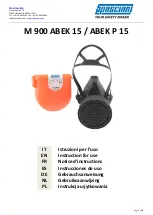
SE Devices
–
Modular Z-Wave Devices
–
Installation Manual
Page 5
Assembly and Installation
Before assembling and installing a Modular Z-Wave device, you need the following parts available:
-
One or more Front Units (FMS-01, FWC-01)
-
A Mounting Frame (1, 2, 3 or 4 slots)
-
One or more Back Unit with Wall-Box mounting Bracket
-
… or a
Cascade Connector to connect to an adjacent unit
Frames available for Installations
There are currently Four (4) different Mounting Frames available from SE Devices. The difference
between the Frames is the number of Front Units (Multifunction Switch and Wheel Controller) which
can be fitted in one frame. Frames are available for fitting 1, 2, 3 and 4 Units in the same frame.
Back Units for Local Control functionality
Each Front Unit can be combined with ONE back unit, where each back-unit type provides a specific
functionality. Back Units also provide Power to the Front unit, and up to 3 Front Units can be
powered from 1 single Back unit (using a Front Unit Cascade connector). Currently the Following
Back Units are available:
-
BMD01
–
SE Devices
–
Mosfet Dimmer Back Unit
-
BD1-10V01
–
SE Devices - 1-10V Dimmer Back Unit
-
BR1P01
–
SE Devices
–
1-Pole Relay Back Unit (3000W)
-
BR2P01
–
SE Devices
–
2-Pole Relay Back Unit (1500W)
All available Back Units are compatible with the Multifunction Switch Front unit. The Font Unit will
automatically adapt to control the fitted Back Unit device.
Optional Components
Optionally the installation can also include Temperature Sensors and Cascade Power Connectors.
The following components can be used in an installation:
-
Room Sensor
–
Each frame supports ONE Room Sensor, which is mounted at the bottom of
the Frame. The Temperature readings can only be accessed by the lowest Front Unit, which
should be considered when installing more than one Front Unit in one Frame.
-
Floor Sensor
–
All but one Back Unit supports an NTC temperature sensor to be connected
via the Connection Terminal. This can be used to measure the Floor Temperature in setups
which controls floor heating. Note that BOTH a floor and room temperature sensor can be
used on one and the same device.
-
Cascade Power Connector
–
Used to install Front Units without a Back Unit. The Front Unit
then gets power via the Cascade Connector. This makes it possible to fit more Front Units
than there is room for in the Wall Box. Note that cascaded Front Units can only control
external devices via Z-Wave.





























